10 Tuscan villages to visit during a trip to Italy
Summer is most people’s preferred time to travel. I am of the opposite persuasion. During summer I work in the city as licensed Florence tour guide and await the eventual subsiding of the Death Valley temperatures. To me, summer means escaping to the Tuscan countryside. So, here are my favorite 10 Tuscan villages to visit! I have been to all of them several times, and I have collected plenty of smart and helpful tips for travelers.
All of those villages look like they were made to satisfy a photographer’s wishes, but in fact have been shaped by centuries of history and still proudly host wonderful traditional festivities. And us people of Tuscany are very proud of them!
10 Tuscan villages you should visit
There are so many beautiful villages in Tuscany really worth visiting, and it’s hard to make a choice and only picking ten of them. So I picked my favorite ones, in a mix of super famous and touristy ones (like San Gimignano) and other ones that are less known and where I love to go to escape to crowds.
Most of them can’t be reached by train, as they don’t have a train station, and there are very few and unreliable buses. The best way to visit them is with a rental car, doing a road trip in Tuscany.
It’s definitely the best way to enjoy not only the villages, but also the countryside landscapes surrounding them. You’ll be driving on secondary scenic roads, surrounded by rolling hills, dotted with farms, cypresses and vineyards. Here is an itinerary for a road trip of 7 days in Tuscany and Florence. Here instad you’ll find all my tips for car rental in Florence and Tuscany.
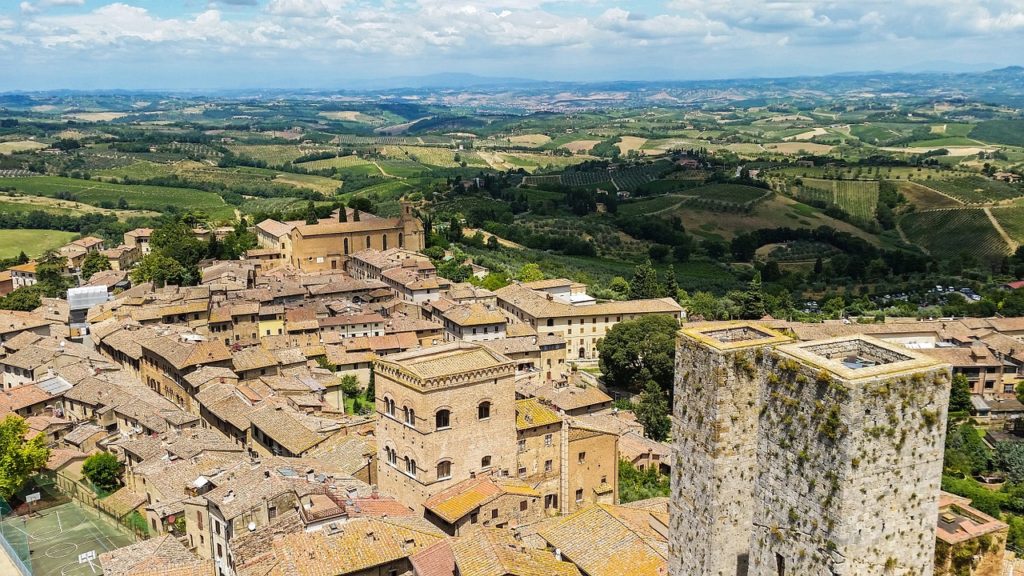
Certaldo
The village of 14th-century writer Giovanni Boccaccio has Etruscan origins but a medieval aesthetic. It is perched upon a hill that is closed to traffic – the village is reached by funicular. Do not miss the museum of Boccaccio’s home or the Pretorio palace with its subterranean prison.
Last but certainly not least, don’t miss out on the onions! Certaldo onions have been famous since antiquity. They feature on the town’s coat of arms and are even mentioned in Boccaccio’s Decamerone, written in the XIV century. Today, they are presided over by a slow food association and are used to make superb dishes, preserves and jams.
The medieval writer Boccaccio is the local celebrity (and a pillar of Italian literature) as he was born in Certaldo. You can even visit his house, that today is a small museum.
You can easily get to Certaldo by train from both Florence and Siena. From Florence it takes 1 hour, from Siena only 45 minutes. If you want to know more, check my favorite things to do in Certaldo.
Most beautiful village to visit in Tuscany: San Gimignano
With its crop of medieval stone towers rising up from the sprawling green mass of Siena’s countryside, this is probably the best-known, most iconic of the Tuscan villages you should visit. Its throng of tourists is unfortunately proportional to this status – every packaged tour of Tuscany passes through – but it is nonetheless too spectacular not to visit at least once! But be aware that San Gimignano can be unbelievably crowded during spring weekends and the whole summer. Try to plan your visit on a weekday if you can.
San Gimignano is famous for its medieval towers, and some people call it “the Manhattan of the Middle Ages”, because it even has two twin towers. Today there are 14 towers left, but they used to be more than 70 in the Middle Ages. You can climb some of them to enjoy the view: the Torre Grossa, which is the tower of the Palazzo Comunale (the town hall) and the Torre Salvucci Maggiore, the tallest one of the two twin towers of San Gimignano. In San Gimignano there is the world famous Gelateria Dondoli, where you can try one of the most awarded gelato in Italy. I personally think that their gelato is good, but not the best. Here you can find the list of all my favorite places for a gelato in Florence.
There are no train stations in San Gimignano, so you can only go there by car. It’s very close to Siena, so the two towns can be easily paired into a single day trip. A great option is taking a day trip from Florence including transportation, lunch and wine tasting.
Bolgheri and Castagneto Carducci
I am putting the two villages together because they’re so close to each other and so small, that 99% of people visit both in the same day. Bolgheri is one of the Tuscan villages of which I am most fond, situated just a stone’s throw from Livorno. Bolgheri is known worldwide for the beautiful cypress-lined avenue connecting it to Aurelia ancient road, which is just perfect for a picture. Is also known for Sassicaia and Ornellaia, two of the world’s most prestigious wines. It is a very quiet place, its old stone houses vineyards, the sea, and cool, mottled hills.
Castagneto Carducci is just a couple of miles away from Bolgheri, and is as beautiful, with its stone houses and the castle at the top. The original name was just Castagneto, then they added Carducci as a tribute to its most famous citizen, the Nobel Prize winner, poet Giosuè Carducci. There is also the house of the poet, that you can visit.
The beach is very close to both with the costal villages of Donoratico and Marina di Castagneto, on what is called Costa degli Etruschi. They are not ancient villages and quite plain compared to pretty Bolgheri. But during the hottest days of summer it’s a pleasure to dip into the fresh waters of the Mediterranean Sea.
If you’re a wine lover, don’t miss the chance to visit some important wineries of the area to taste their wines. I recommend visiting the Ornellaia Winery, Terre del Marchesato cellars and the ones of the Castello di Bolgheri, where you can do some great wine tasting experiences.
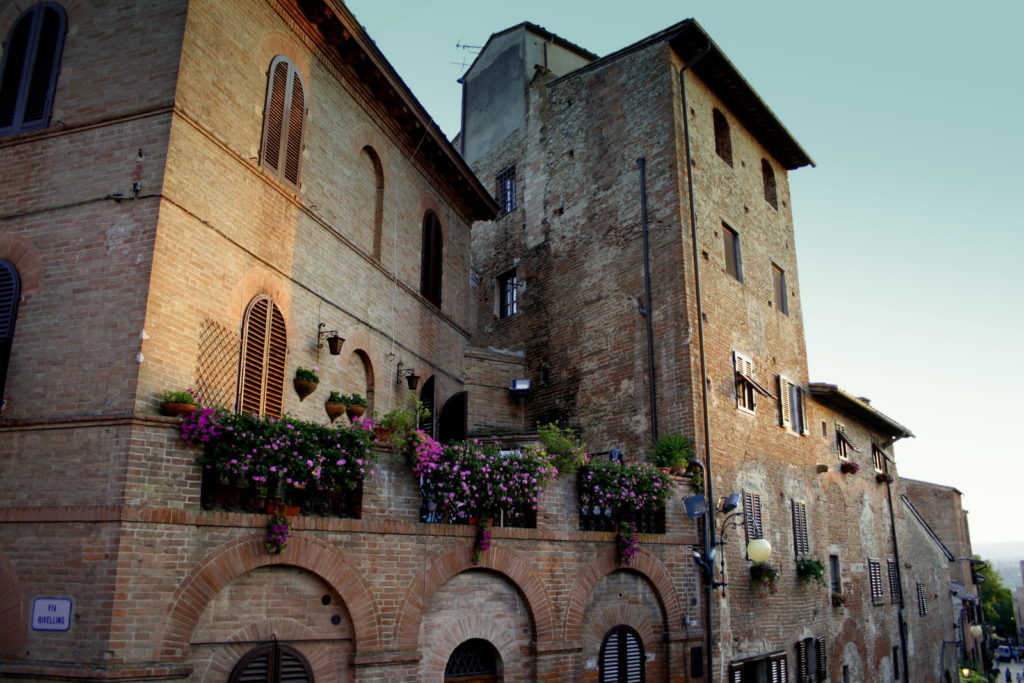
Volterra
Volterra is a wonderful little Tuscan village on the top of a hill, still surrounded by its medieval walls. Even if most of what you see in Volterra is medieval, the history of the village is much older, as it used to be one of the most important cities of the Etruscan civilization. Years before the birth fo Christ, Volterra was a city-state specialized in the production of objects made of alabaster, a stone which is almost transparent when cut into thin slabs. The Etruscan past is still there: you can still see part of the ancient Etruscan walls, that were used as a base for the medieval ones. And there’s a wonderful archaeological museum housings thousands of Etruscan and Roman findings. Even the tradition of the alabaster production is still alive. It’s still locally sourced, and turned into beautiful little objects made of this milky, transparent stone, that you can bring home.
Volterra is equally close to Pisa (70 km) and Siena (60 km), so you can visit it in the same day of one of those two cities. Or you can find a beautiful agriturismo in the countryside near Volterra, and use it as a base for visiting the other two cities.
If you like medieval reenactments, Volterra is the place to be in mid-august: there is the biggest medieval festival in Italy! The whole village makes a step back to A.D. 1398 for a week, bringing the Middle Ages alive again. It’s called Volterra A.D. 1398, be sure to book months in advance if you want to attend it!
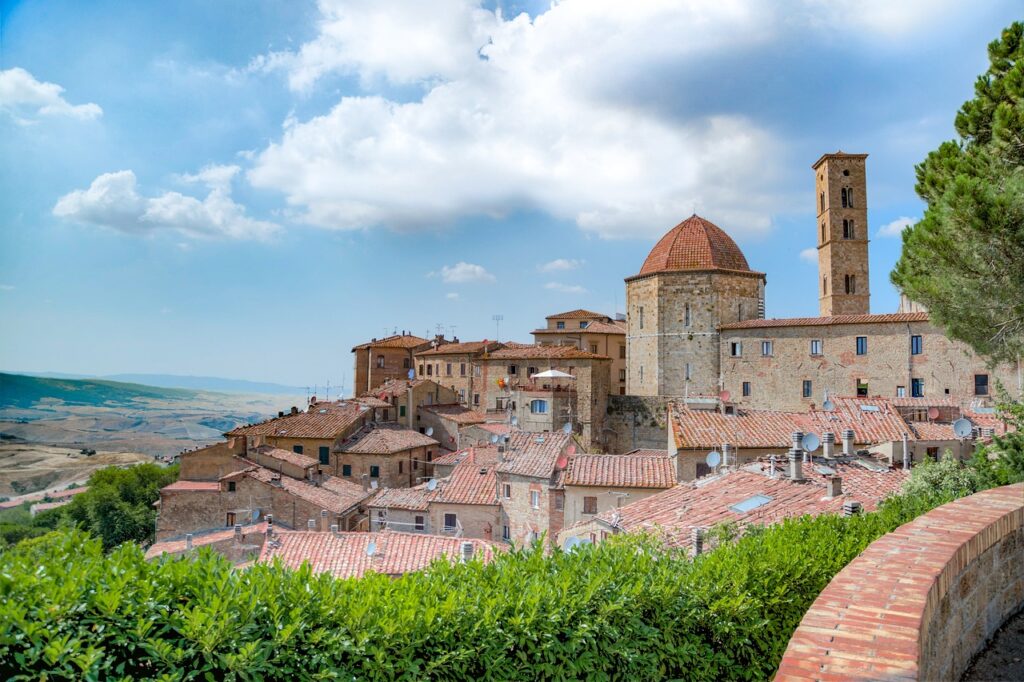
Monteriggioni, best medieval village in Tuscany
When you look at Monteriggioni from a distance, it really looks like an illustration from a book of fairytales. It lies on a hill outside Siena, its castle enclosed by mighty fortifications from which 14 square towers sprout. Cars can’t enter into the medieval walls, so the atmosphere of the village is really bringing you back to the Middle Ages.
Start your visit of Monterggioni entering from the Porta Franca, one of the three doors of the walls, and reach the main piazza, Piazza Roma. Here you can visit the Pieve di Santa Maria dell’Assunta, a church built in the 13th century. Then walk on the city walls to enjoy the view from above and to learn more about how villages and castles would defend themselves in the past. There is also a small military history museum, focused on the strategies of the Middle Ages.
Every summer, at the beginning of July, the village stages a medieval reenactment named Monteriggioni di torri si corona (that means Monteriggioni crowned by towers), as Dante described it in the Divine Comedy.
Monteriggioni is located in between Florence and Siena (but more close to Siena). So it makes a perfect stop during a road trip in Tuscany, while driving from Florence to Siena. Unfortunately is complicated to get there with public transport, so if you don’t drive and still want to see such a beautiful hamlet, the best thing to do is doing an organized tour of Tuscany that includes also Monteriggioni, with transportation and lunch.
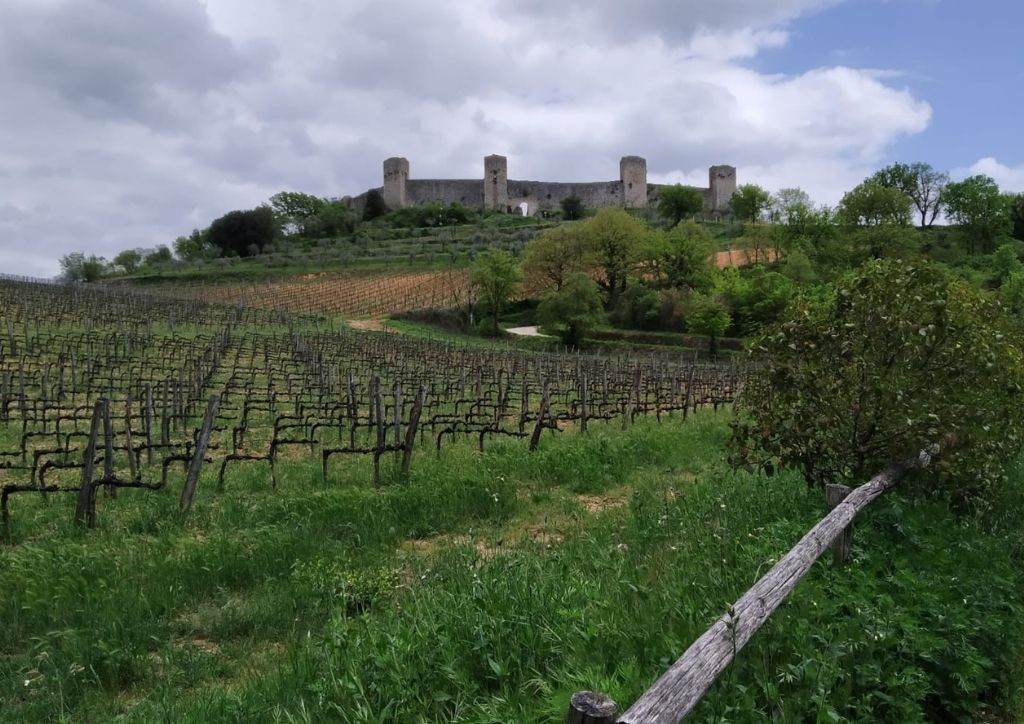
Scarperia, beautiful village near Florence to visit
Mugello is one of the most wild, beautiful and authentic valleys in the province of Florence, and Scarperia is its crowning jewel, one of my favorite Tuscan villages that I always recommend to visit. One of the reasons why I love Mugello is that is still pretty underrated and not as touristy as Chianti.
Scarperia is renowned since the Middle Ages for its ancient knife craftsmen. It’s still surrounded by its medieval walls, and you can walk on the top of them and enjoy the view of the countryside and the village from above. The Palazzo dei Vicari, built in the 13th century, dominates the main piazza with its facade, decorated with dozens of coats of arms. You can enter to see the beautiful courtyard with frescoed ceilings, and to visit the small but interesting museum dedicated to the history of knife-making (Museo dei Ferri Taglienti). The rest of the palace is still used as the town hall.
Nearby Scarperia there are two of my favorite secret spots in Mugello Valley. If you are driving around I highly recommend you to make a small detour to see both of them. The first is the wonderful romanesque church of Sant’Agata, that dates back to the X century. Sant’Agata is a tiny hamlet just a few kilometers away from Scarperia, it’s a short stop along your way to Scarperia, but definitely worth a visit. The second one is the convent of Bosco ai Frati, just 12 km away from Scarperia. It’s a masterpiece of Renaissance architecture where Franciscan friars are still living. Inside of the convent there’s a wooden crucifix attributed to Donatello, the friars are happy to show it to visitors.
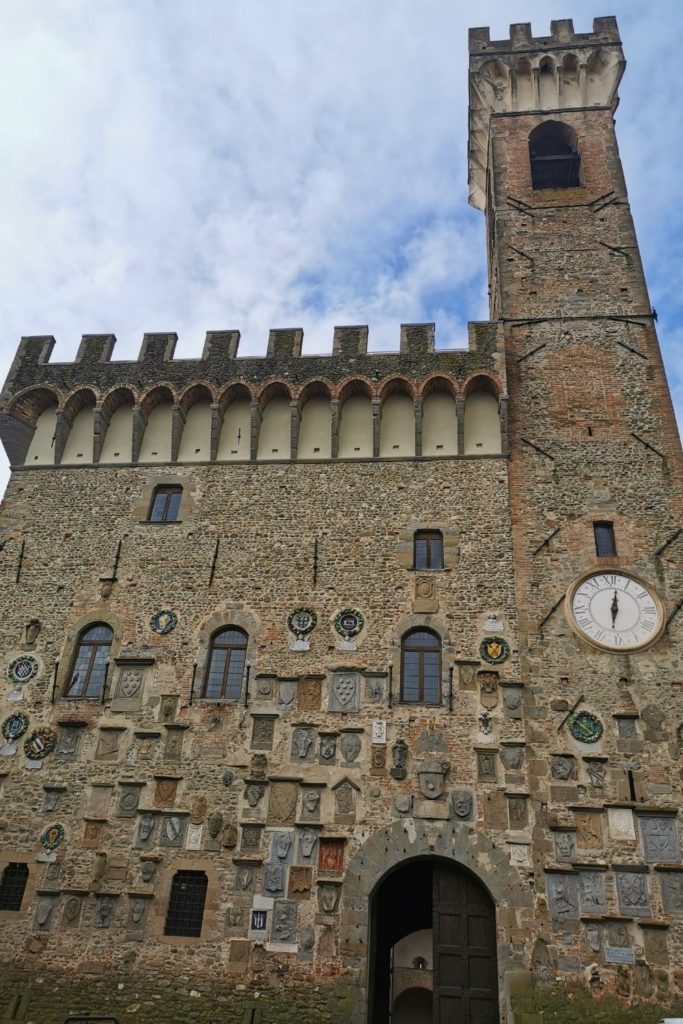
Borgo a Mozzano
The name of the village is unlikely to be familiar, but its wondrous bridge might be. The Ponte de Diavolo (Devil’s Bridge) stretches its characteristically crooked, asymmetrical back over the Serchio river, linking Borgo a Mozzano to the pastures beyond. This medieval village is hung on the side of a steep mountain, and until not a long time ago, the Devil’s Bridge was the only way of communication with the rest of world. But even today Borgo a Mozzano is still a very isolated village, even if not far away from the city of Lucca. On October 31st the village hosts a magnificent Halloween party to which people from all over the country travel.
Borgo a Mozzano is located on the Apennines, the mountains going from north to south along the entire boot of Italy, like a spine. It’s in the province of Lucca, and can be reached only by car, as it’s very small and isolated. I also love the close-by village of Bagni di Lucca, once a very popular thermal bath town nestled on the mountains. Today is almost abandoned and looks like a ghost town from the 19th century. Both Bagni di Lucca and Borgo a Mozzano are a perfect adding if you are visiting Lucca. Learn more about how to get from Florence to Lucca.
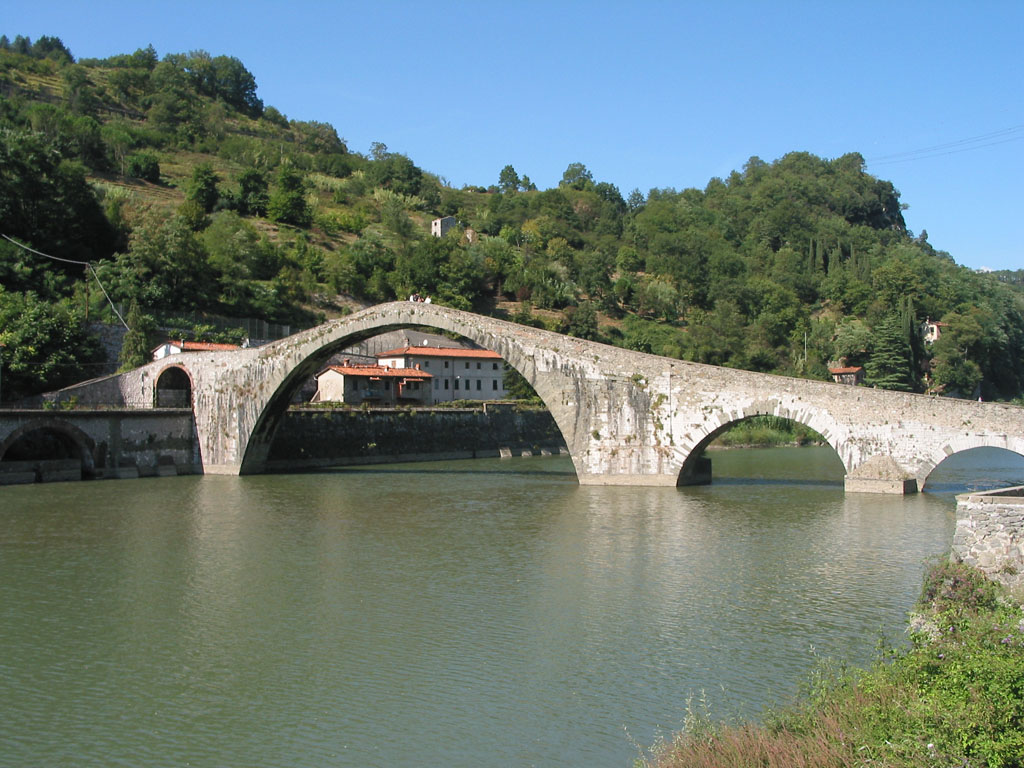
Cortona and the Val d’Orcia valley
Located on Tuscany’s border with Umbria, this once-Etruscan settlement still retains an authentic historical atmosphere. Its city walls are made of at least three different layers: the oldest one are the leftovers of the Etruscan walls, that were then completed by the Romans, and then reinforced in the Middle Ages. Wander around the alleys and cute little piazzas, enter into ancient churches to enjoy the art and architecture, and then reach the fortress Fortezza del Girifalco. It’s sitting at the highest point of Cortona, and from here you can enjoy a beautiful view of the village and the Tuscan landscape all around it.
You can see the paintings of one of my favorite and underrated Renaissance artists, Luca Signorelli, the church of San Niccolò. Do not miss out on a trip to Eremo le Celle, a nearby monastery immersed in forest, founded by Saint Francis of Assisi in the XIII century. It’s one of the most beautiful and peaceful places I’ve ever been, and monks are still living there. Cortona is also home to an important archaeological museum dedicated to the Etruscan civilization.
The whole area around Cortona, called Val d’Orcia, is one of my favorite parts of Tuscany. There are many other wonderful villages, like Bagno Vignoni, with the unique medieval pool to collect thermal waters. Or San Quirico d’Orcia, which is very close to Cortona, so you can visit both villages at the same time.
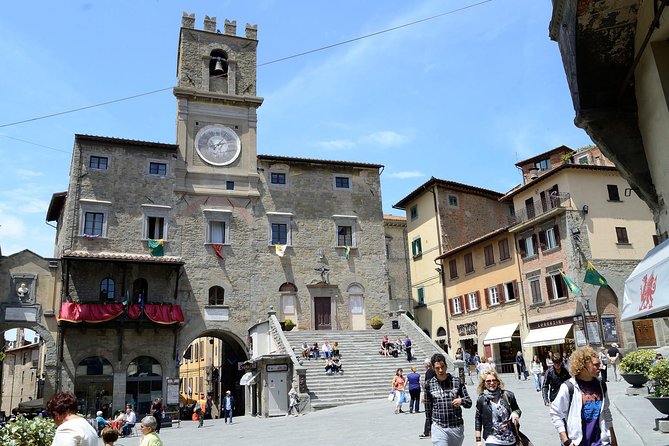
San Quirico d’Orcia
San Quirico d’Orcia used to be a very important town in the Middle Ages. Being located on a crossroad along the Via Francigena, the road that was connecting France to Rome, became an important stop for medieval, traveling merchants. Today the village is mostly untouched, and is still so beautiful that has became a world UNESCO heritage site. I love walking around the Horti Leonini, a wonderful Renaissance Italian garden. And don’t forget to visit the beautiful Palazzo Zandodari, with its baroque frescoed ceilings from the 17th century.
The countryside around San Quirico d’Orcia produces some of the best extra virgin olive oil in the world (check this post to know more about tuscan extra virgin olive oil). Every year the village celebrates its work with its Oil Festival! That’s a great chance to taste not only the oil, but all of the yummy products made in the Val d’Orcia valley. Cheeses, salami, truffles and much more.
Extra tip: during your road trip, when heading to San Quirico, make a quick stop to see one of the most iconic little churches of Tuscany, with some cypresses on the sides, and surrounded the rolling hills. It’s the chapel of the Madonna di Vitaleta (here you can find it on Google Maps). In the ancient farm next to the chapel there’s a small, very romantic fine restaurant, Gourmet Vitaleta, which is just perfect for a special anniversary.
San Quirico is very close to Cortona, both nestled in Val d’Orcia. That’s two peas in a pod! The Val d’Orcia Valley is full of pretty little villages, and you can easily spend 3 or 4 days on a road trip, just in that area. If you want to know more about all of them, read my blogpost about the best villages to visit in Val d’Orcia.

Bibbona, underrated Tuscan village to visit
Bibbona is a small medieval Tuscan village to visit in the Val di Cecina valley. It’s very underrated, being close to its more famous neighbors Bolgheri and Castagneto Carducci. Bibbona is as beautiful as them but definitely less touristy. Walking around the village, you can visit some pretty little churches as the medieval Pieve di Sant’Ilario or the Renaissance church of Santa Maria della Pietà.
Bibbona is surrounded by a gorgeous mediterranean forest and the beaches of Marina di Bibbona and Costa degli Etruschi (Etruscan Coast) are at a stone’s throw. Marina di Bibbona, just like the other villages on the Etruscan Coast such Donoratico and Marina di Castagneto, is nothing special. It’s a quiet little beach town built in the XX century, but again, it’s perfect if you want to walk on a long stripe of sand and dip yourself in the Mediterranean Sea, at the end of summer day. Instead, if you are into hiking and birdwatching, I recommend you visiting the Macchia della Magona, a protected natural area with a rich Mediterranean forest, home of hundreds of birds.
The train station is about 6 km away from the Bibbona, and there are very few connecting buses (one every 90 minutes or so). So the only really doable option is the car.

Map of the best villages to visit in Tuscany
I have pointed all the villages I mentioned in this post on a Google map, that you can use to calculate the distances and to have an idea of the roads. You can also understand which villages are closer to each other, to better plan your road trip in Tuscany. I hope you’ll find it helpful to decide which Tuscan villages to visit.
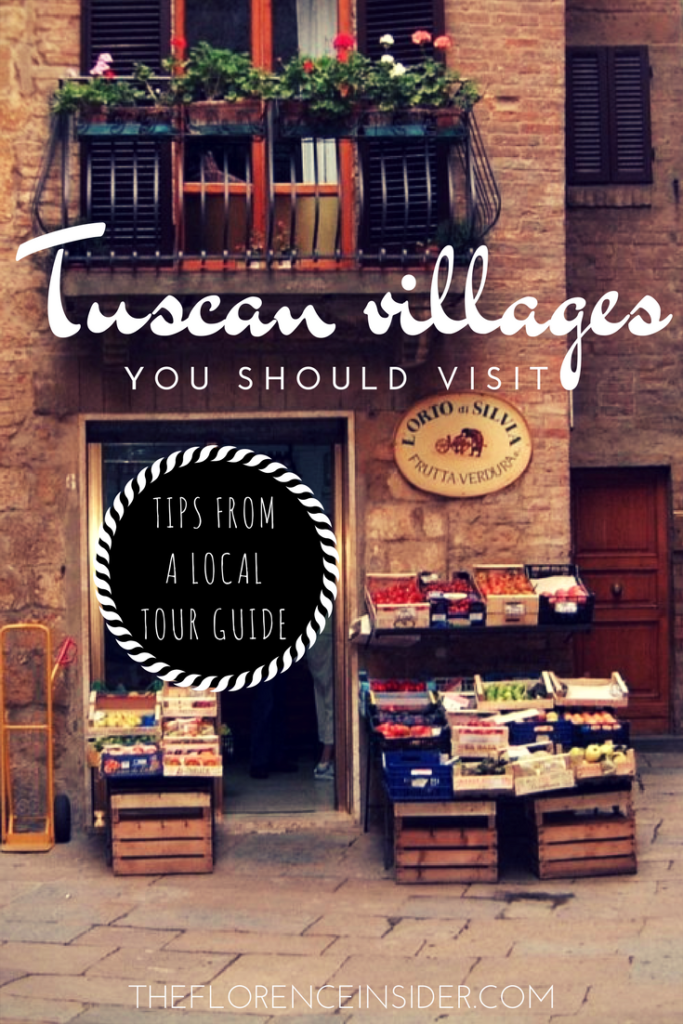
Several years ago we enjoyed two weeks exploring Tuscany. The only plan we had was a long weekend in Florence. We went wherever the road took us, booking a hotels as we went. We had a fantastic two weeks but did feel as though we lost time constantly packing / unpacking as we moved from one hotel to the next.
We’d love to do a Tuscan road trip again, but this time we’d spend a few days in each town and do day trips from there before moving on to the next town. Something worth considering when you’re planning your own road trip.